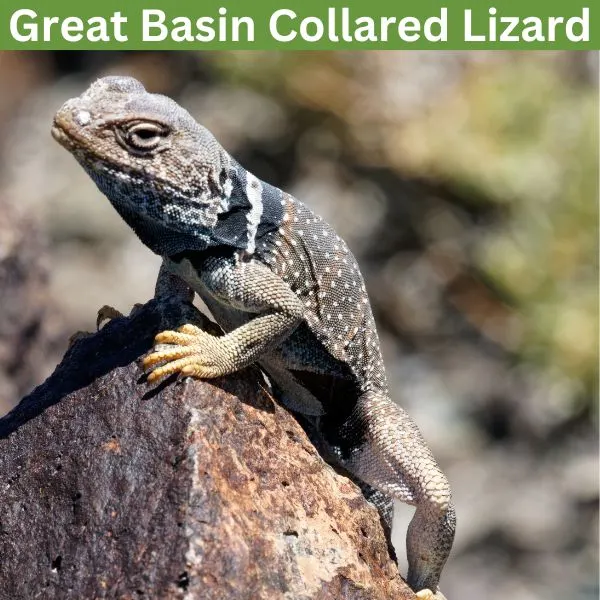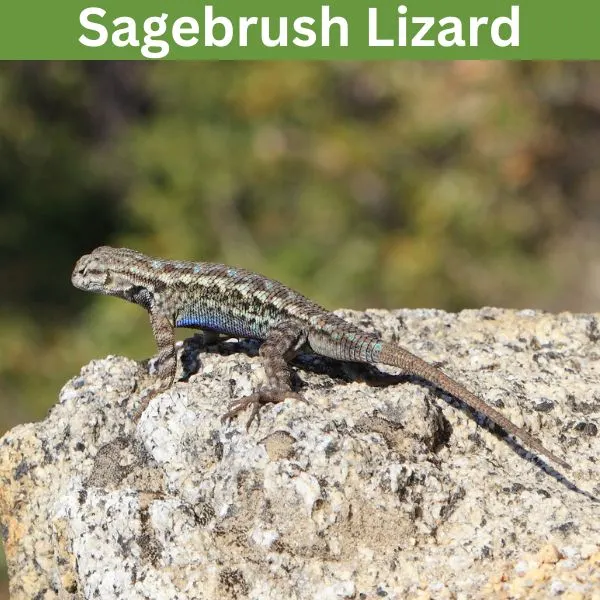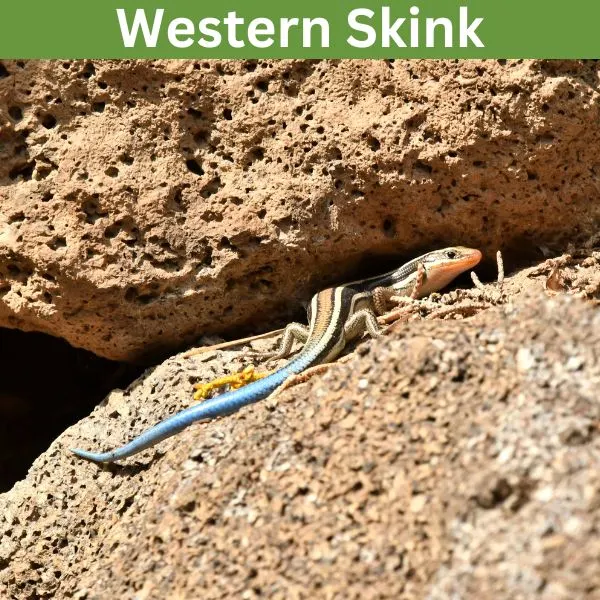Oregon is home to 12 lizard species that live across the state’s diverse habitat. Lizards only live in their preferred habitat which can be woodlands, prairies, deserts, coastal dunes, and some are even common to sight in urban areas near homes.
Many lizard species may look very similar to each other. You can identify a lizard species by looking at its physical traits like scales, colors, patterns, and size. The location where a lizard is found, and their habitat is also useful for identifying lizards.
Let’s take a look at the 12 lizards that live in Oregon, and where you can find these sneaky reptiles. Some of the lizards in the state may be losing populations, and learning about them can help educate on preserving the wildlife.
Table of Contents
Lizards in Oregon
Anguidae
1. Northern Alligator Lizard

- Experience Level: Intermediate
- Family: Anguidae
- Scientific Name: Elgaria coerulea
- Other Names: n/a
- Adult Size: 10.8 in. (27.5 cm.)
- Lifespan: 7 years
- Average Price Range: $50
Northern Alligator lizards are native to the 2 thirds western region of Kansas. This lizard lives in forests, and chaparral habitats. They are active for most of the year, but when winter comes this lizard undergoes brumation to survive the cold.
The northern alligator lizard is a medium-sized species, with greenish, yellow, or brown coloring. The scales of these lizards are keeled, and blotches sometimes appear on their body that form bands.
When breeding these lizards are one of the few that give birth to live young. They can lay up to 15 younglings, and breed in the spring, and summer. Younger northern alligator skinks may have yellowish color. The eyes of this species are dark, and their bellies are gray.
Insects like crickets, beetles, slugs, moths, and spiders are what these lizards eat. Leaf litter, and vegetation is used by this lizard for cover. They lung and use their quick jaws to snatch up prey.
2. Southern Alligator Lizard

- Experience Level: Intermediate
- Family: Anguidae
- Scientific Name: Elgaria multicarinata
- Other Names: n/a
- Adult Size: 3 to 7 in. (8 to 18 cm)
- Lifespan: 7 years
- Average Price Range: $350
Southern alligator lizards are found in the western portion of Oregon. These lizards live in woodlands, grasslands, rocky areas, near creeks, and open forests. Southern alligator lizards are active in the day, and when not out basking in the sun they may hide under debris like logs, or rocks.
These lizards have roughly keeled scales, with a robust body, and small limbs. Their colors range from grayish, tan, to dark brown. Southern Alligator lizards have a wavy pattern that runs down their bodies.
Southern alligator lizards eat animals like lizards, slugs, mice, eggs, and birds. They also eat spiders, and studies showed this lizard had some immunity to black widow venom.
Near human homes, and other buildings the southern alligator lizard can be spotted in the day. They are seen most in the spring, and breed year round. In their habitat this species has a stable population.
Crotaphytidae
3. Great Basin Collared Lizard

- Experience Level: Intermediate
- Family: Crotaphytidae
- Scientific Name: Crotaphytus bicinctores
- Other Names: Mojave Black-collared Lizard
- Adult Size: 2.5 to 4.5 in. (6.4 to 11.4 cm.)
- Lifespan: 10 to 12 years
- Average Price Range: $60
Native to the western United States, the Great Basin collared lizard can be sighted in a small region within the southeastern portion of the state. Great Basin collared lizards are found in rocky, and arid desert regions. They are often seen in the southeastern portion of the Great Basin desert, as well as the Mojave, and Sonoran deserts.
Great Basin desert lizards are named after the black collared marking that appears around their neck. This lizard has brown to orange coloring. Males sometimes have red, or pinkish coloring on their undersides. Blotches, spots, and bars appear over this lizard. The scales of these lizards are small and beaded.
The powerful jaws of the Great Basin collared lizard is where this lizard lives. They sometimes feed on snakes, rodents, or smaller lizards. Plants and insects also make up parts of this lizard’s diet. Great Basin desert lizards are a common species, with a stable population.
4. Long-nosed Leopard Lizard

- Experience Level: Intermediate
- Family: Crotaphytidae
- Scientific Name: Gambelia wislizenii
- Other Names: n/a
- Adult Size: 3.25 to 5.75 in. (8.225 to 14.6 cm.)
- Lifespan: 5 to 8 years
- Average Price Range: $20
The long-nosed leopard lizards are native to the western United States. In Oregon these lizards are found in the far southeastern portion of the state. These lizards are found in semi-arid plains, grasslands, and other desert-like habitats with sparse vegetation. From sea level to 6,000 ft. (1.8 meters.) is where these lizards live.
Long-nosed leopard lizards have a cream, white, or grayish color. They have brown spots that cover their head and body, which inspire their name. These lizards have bar patterns on their very long tails.They also have long toes which help them move across their sandy habitat.
May to June is when the breeding season of the long-nosed leopard lizard occurs. They lay between 5 to 6 eggs, which hatch later in the summer. Insects, rodents, and spiders are what this lizard eats. Urban development, farming, and oil mining have destroyed this lizard’s habitat, and made their populations smaller.
Phrynosomatidae
5. Common Side-blotched Lizard

- Experience Level: Beginner
- Family: Phrynosomatidae
- Scientific Name: Uta stansburiana
- Other Names: n/a
- Adult Size: 2.5 to 5 inches (6.35 to 12.7 cm.)
- Lifespan: 1 year
- Average Price Range: $12
Common side-blotched lizards are native to the western regions of North America. This lizard is found in the southeastern portion of Oregon. Common side-blotched lizards live in a variety of habitats from rocky canyons, sand dunes, road edges, and shrublands.
These lizards are named after the dark spot that appears on their sides. Males of this species sometimes have blue specks on them. The sides of this lizard sometimes have yellow, or orange markings. These lizards have roughly keeled scales, with a tan, to grayish base color.
Common side-blotched lizards breed in the spring months. This lizard breeding has been studied heavily, mainly due to how the different morphs of this species breed. Males with an orange throat are ultra-dominant, and use aggression to get mates. Yellow-throated side-blotched lizards will sneak to breed with a mate, while blue-throated ones will guard territories.
The different morphs of these lizards all have different advantages over one another. To avoid predation common side-blotched lizards will flee. They feed on arthropods, like insects and spiders. The breeding season is when this lizard is active the most, and they have a stable population in their range.
6. Pygmy Short-horned Lizard

- Experience Level: Intermediate
- Family: Phrynosomatidae
- Scientific Name: Phrynosoma douglasii
- Other Names: n/a
- Adult Size: 1 to 3 in. (2.5 to 6.5 cm.)
- Lifespan: 10 years
- Average Price Range: n/a
Pygmy short-horned lizards are found in the eastern region in Oregon, and have a range that covers the northwestern United States. These lizards live in open coniferous forests, deserts, woodlands, and sagebrush habitats. The day during spring to fall is when these lizards are active.
The pygmy short-horned lizard is a small lizard with a spiny appearance. Tan, yellowish, or gray are the colors these lizards appear in, and they have a body covered in spikes. Pygmy short-horned lizards have a round and flat body. Their coloring and spikes help them camouflage into vegetation and hide from predators.
These lizards mainly feed on ants, but also eat other types of insects. This lizard is capable of living in higher elevations. They are active until winter, which is when they hibernate in the cold.
7. Desert Horned Lizard

- Experience Level: Intermediate
- Family: Phrynosomatidae
- Scientific Name: Phrynosoma platyrhinos
- Other Names: n/a
- Adult Size: 3.75 in. (9.5 cm)
- Lifespan: 5 to 8 years
- Average Price Range:$40
The desert horned lizard is found in the southeastern area of Oregon near the borders of Nevada, and Idaho. These lizards live in sandy desert habitats, low mountain areas, and rocky regions. They are often found in habitats with shrub vegetation, and sandy soil.
Desert horned lizards have a tan, or yellow coloring, with spikes on them that help them blend into their semi-arid environments. These lizards have pointed, spiky scales that come out of their back. Dark blotches appear on their scales, and body, and they also may have a dorsal stripe.
The shape and spikes of these lizards make them less palatable to some predators. The desert horned feeds on ants, crickets, worms, flies, beetles, and other similar invertebrates. If attacked they try to make themselves bigger, and puff out their chests. In their range these lizards are very common in semi-arid places.
8. Sagebrush Lizard

- Experience Level: Intermediate
- Family: Phrynosomatidae
- Scientific Name: Sceloporus graciosus
- Other Names: Sagebrush swift
- Adult Size: 2 to 5.9 in. (5 to 14.98 cm.)
- Lifespan: 5 years
- Average Price Range: n/a
The sagebrush lizards are found near the western, and northern United States. These lizards live in shrublands, and woodland habitats. They enjoy basking in the sun, and are seen most near the ground. Sagebrush lizards live in rodent burrows, and will stay there during the cold winters, or very hot days.
Sagebrush lizards are a smaller to medium species, with gray, brown, or olive coloring. They have banding that appears on their body and tail, with tannish spots on them. The scales of these lizards are very keeled, and their tails are thin, and long. Sagebrush lizards may have a blush, or green markings on the sides of their stomach.
Being smaller these lizards are preyed on by animals like whipsnakes, night snakes, birds, cats, and small carnivorous mammals. In a clutch this lizard lays 2 to 10 eggs, which are placed in loose soil. Small animals like ants, insects, grasshoppers, and spiders are what this lizard eats.
9. Western Fence Lizard

- Experience Level: Intermediate
- Family: Phrynosomatidae
- Scientific Name: Sceloporus occidentalis
- Other Names: Blue-belly lizard
- Adult Size: 4 to 7.5 in. (10 to 19 cm.)
- Lifespan: 5 to 7 years
- Average Price Range: $20
California is where the western fence lizard mainly lives, but these lizards are also found in the southeastern regions of Oregon, and other nearby states. Western fence lizards are a very common species in North America. These lizards are found in woodlands, deserts, grasslands, farmlands, and cities.
Western fence lizards have very roughly keeled scales,with gray, black to tan coloring. Males have blue coloring on their bellies, while younger specimens and females have dull coloring. Some male populations may also have blue on their throats and sides.
Spring is when this lizard is most active, and is often seen on fences, large rocks, or other similar structures to bask in the sun. These lizards are able to change their shade to help them better thermoregulate. Insects, and other types of small invertebrates is what these lizards eat.
Scincidae
10. Western Skink

- Experience Level: Beginner
- Family: Scincidae
- Scientific Name: Plestiodon skiltonianus
- Other Names: n/a
- Adult Size: 4 to 8.25 in. (10.16 to 20.95 cm.)
- Lifespan: 10 years
- Average Price Range: n/a
Western skinks are native to the western United States, and can be found in the majority of Oregon. These lizards are found across the state in places like urban areas, grasslands, forests, and dry hillsides. Western skinks are common in heavily vegetated areas, with moist soil.
Western skinks when born have a bright blue tail, which fades with age. They have a tan, or olive color, with dark stripes down their sides. The scales of these lizards are smooth. Western skinks are more vibrant when young, and begin to lose colors as they age.
The day is when the western skink is active, and they are more common during the warm time of the year. These lizards hibernate in the winter, and are a species that may live together in dens. Western skinks reach sexual maturity at around 3 years of age, and during the summer they lay between 2 to 6 eggs. Spiders, beetles, grasshoppers, and other arthropods are what this lizard’s diet is made of.
Teiidae
11. Western Whiptail

- Experience Level: Intermediate
- Family: Teiidae
- Scientific Name: Aspidoscelis tigris
- Other Names: n/a
- Adult Size: 9.8 to 13.7 in. (25 to 35 cm.)
- Lifespan: 7 years
- Average Price Range: n/a
Western whiptails are a lizard native to the western United States, and have a population within Oregon in the southeastern portion of the state. Western whiptails are found in dry woodlands, chaparral, and riparian habitats. They prefer areas with lots of vegetation, and also use burrows to hide.
The body of the western whiptail is slender and long. They have small scales, with a pointed head, and long and thin tail. This lizard has tannish coloring, with blotches on them. These lizards can also have a yellow, greenish, or olive coloring.
Breeding for this species occurs in the summer, and females lay their eggs at the beginning of fall. Females can lay up to two clutches a year. Insects, spiders, scorpions, beetles, and other invertebrates are what these lizards eat, and they use their quick speed and tongues to catch prey.
12. Plateau Striped Whiptail

- Experience Level: Intermediate
- Family: Teiidae
- Scientific Name: Aspidoscelis velox
- Other Names: n/a
- Adult Size: 2 to 5 in. (5 to 12.7 cm.)
- Lifespan: 7 years
- Average Price Range: n/a
The plateau striped whiptail is a species that has been introduced to Oregon, and is native to states like Utah, Arizona, Colorado, and New Mexico. Grasslands, riparian, foothills, canyon, and sloped habitats is where these lizards live. They are active in the day, spending their mornings foraging on the ground.
Plateau striped whiptails are brown, to black colored. They have very slender bodies, with extremely long tails. This species has yellowish, or cream stripes that run down their body. When young this species has a blue tail.
These lizards are active for most of the year, but hibernate in the winter. They feed on organic matter, or insects. These lizards will dig near rocks or plants to look for their foods.
FAQ
What lizards are the most common in Oregon?
The western skink is one of the most common lizards that live in Oregon, and are also known as the lizards with blue tails. Often you can see these lizards near urban areas, around homes, and in backyards.
Is it ok to touch wild lizards in Oregon?
Lizards can carry diseases, and if you handle a wild species it may stress them out so it is best to avoid handling them unless necessary. If you have to come in contact with a lizard you should wash your hands immediately after. Lizards typically flee when approached, and most are harmless, but may bite if cornered.
Wrapping up
Lizards in the wild, or in captivity are interesting animals to watch. Some of the lizards in Oregon are species that may make a good pet, but you should never take one from the wild to keep. Wild lizards are important parts of their ecosystem, and also die quicker than captive bred lizards since they have parasites and disease.
The wild populations of lizards in Oregon may see a decline due to the destruction of their habitats, pollution, and climate change. Lizards are useful to humans since they feed on pest insects, and spiders. There are many lizards in the wild of Oregon, and you may not even see them unless you know where to look.
Lizards in other nearby states
Table of Contents
